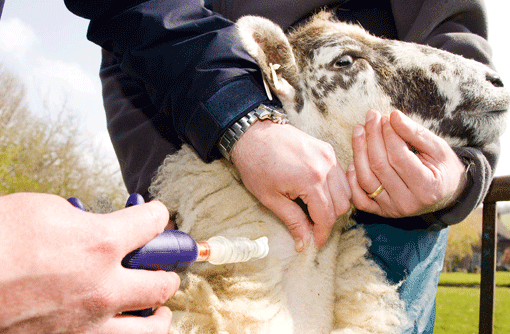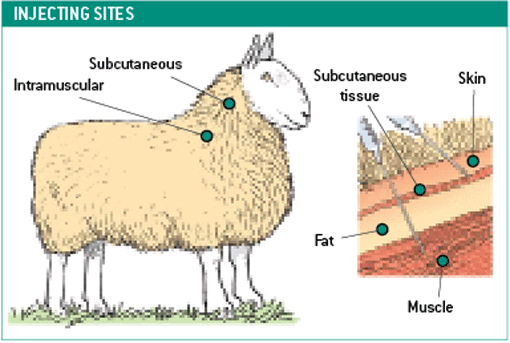Advice on vaccinating sheep

Vaccines are an important part of a sheep farmer’s fight against disease – but handled incorrectly they can become ineffective, or worse, actually cause infection.
In a pilot study of 80 farmers across Worcestershire, vet Anne Gibbs, partner at MacArthur, Barstow & Gibbs Veterinary Surgeons, found that well over a third of sheep farmers questioned were not using vaccines according to manufacturers’ recommendations.
Many were blaming disease breakdowns in their flocks on the vaccine itself, but it is possible it was actually their handling of it that was limiting its efficacy.
“We had a couple of vaccine breakdowns and I had an inkling that sometimes products weren’t being used in the way they should be,” says Mrs Gibbs. “But people also need to recognise the limitations of a vaccine and have realistic expectations of what it can do.
“Many people still believe that they won’t get any problem with a disease after vaccinating, but that simply isn’t the case, because there are so many other factors which come into play.”
Storage
• Draw up a health plan with your vet.
• Always read the label, even if you have used the product previously, as instructions, particularly withdrawal periods, can change.
• Follow the instructions.
• Store in a locked container at the recommended temperature.
• Record the use of all medicines and vaccines.
• Check the expirzzy date and discard open vaccine vials after 24 hours.
One of the most common mistakes made by farmers is not storing vaccines correctly before use – something which may become a greater problem with the growth of online sales.
“Many vaccines need to be kept refrigerated – and that includes during transport,” says Mrs Gibbs.
“Often farmers will buy clostridial and pasteurella vaccines at a country store not realising they should be refrigerated until they are used. If it is left to heat up in the car, the product will not be as active or effective as it should be.”
Using the same equipment for different vaccines may cause contamination, and injecting the animal in the wrong place will affect the animal’s uptake of, and response to, the vaccine, she adds.
As well as correct handling of a vaccine, it is important that farmers understand how it actually works.
“Some farmers are very good, but there is a significant proportion out there who buy the vaccine, put it in the animal, but don’t realise what happens next. It is up to the vets and suitably qualified personnel to pass on more information and best practice.”
When a vaccine is administered, it is detected by white blood cells, which react as if the real infectious organism has entered the body. They multiply and start to produce antibodies to fight the disease.
These remain in the system, ready to attack should the animal later come into contact with the real disease.
However, if the animal is already under disease pressure, or the vaccine is administered incorrectly or at the wrong time, the sheep may not be able to produce as strong a reaction as it should, leaving the door open for potential later infection.
Timing
“You need to consider whether the animal is in good enough shape to be able to respond well to the vaccine you are giving it,” says Mrs Gibbs.
Vaccinating lambs too young will mean maternal antibodies derived from colostrum may block the action of the vaccine and thus fail to produce the expected protection.
Vaccinate them too late and they may already have contracted the disease.
Pregnant ewes respond less well to primary vaccinations, so farmers should vaccinate for clostridial diseases and pasteurella well before tupping.
A well-timed booster, given before lambing, helps to maximise maternal antibodies, which are passed onto the lamb via colostrum.
“Quite a few people only give one dose of a vaccine and either don’t give the second dose at all, or not within the correct timeframe.
“The most common mistake is not giving lambs a second dose of clostridial vaccine around weaning, before they enter the higher risk period in the autumn. It’s all about planning the right timing and making sure dose intervals are what they should be.”
Most farmers tend to handle abortion vaccines correctly, as they are sourced through a veterinary practice and are relatively expensive.
“The vaccines that seem to be disregarded the most are the cheap ones like clostridia and pasteurella. But farmers are wasting a lot of money if they are not using these vaccines correctly. They should be getting maximum benefit from what they buy.”
Administration
Different vaccines must be handled and administered in different ways, so farmers should read the data sheet and follow its protocols, she adds.
Some must be given subcutaneously – just under the skin – while others should be intramuscular – into the muscle (see diagram, left).
An EBLEX report on best practice says subcutaneous injections need to be administered with care to ensure the product is placed under the skin and not into fleece or muscle: “The sheep needs to be well restrained and the skin ‘tented’ away from the underlying muscle.
“The injection site is 10-15cm below the ear. Usually a 1.6cm needle is ideal. After administration the site should be gently massaged to ensure good dispersion of the product.”
Intramuscular injections should be given on the side of the neck, 10-15cm in front of the shoulder in the mid neck area well above the large jugular vein.
“Insert a 2.5-4cm needle at 60° to the neck aiming inwards and upwards towards the head. Again massage in after administration.”
Using the correct site for injections ensures optimum absorption of the vaccine, and reduces the risk of damaging valuable meat cuts.
Needles should be changed frequently to avoid the risk of tissue damage and infection. Mrs Gibbs explains a study carried out by Bristol Vet School found up to 56% of sheep and goats showed local reaction 24 hours after clostridial vaccination.
After administering vaccines, farmers should dispose of needles in a sharps box and throw away open vials.
Open vaccines may be contaminated by bacteria so they should be disposed of in accordance with manufacturers’ guidelines.
They should also record all vaccinations in the medicine ledger, along with batch numbers of the individual vaccines.
“It is worth sitting down with your farm vet once a year, to review what vaccines are being used and what disease pressures there are. Create a flock health plan and check that you are doing everything right. Vaccines will do a good job if used correctly alongside good flock management.
“But get it wrong and you will have lost money twice over – wasted on an ineffective vaccine and via resulting disease losses.”

Sponsor’s message:
Use your vaccines wisely

In the sheep sector, there are a number of vaccines available that help producers to
control a range of economically-damaging diseases such as clostridial and pasteurella problems, enzootic abortion, footrot and orf, but these products must be used correctly to work effectively.
This means following manufacturer guidelines and product usage instructions as strictly as possible.
Make sure primary vaccination courses are always completed, needles are changed regularly and products are stored as directed. Producers should also throw away any leftover vials in accordance with manufacturer directions.
Flock Focus
